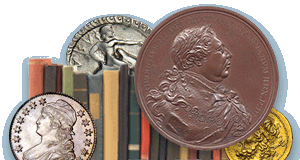
PREV ARTICLE
NEXT ARTICLE
FULL ISSUE
PREV FULL ISSUE
COLONIAL GEORGIA COLORED SEALS, PART 1Moving from counterfeit notes to real ones (and real interesting ones at that), here's a view into Bob Rhue's exhibit of "The Colored Seal Notes of Colonial Georgia", which won the American Numismatic Association's Howland Wood Memorial Award for Best-of-Show exhibit back in 2017. I was impressed with the exhibit at the time, and felt the exhibitor was a kindred spirit with a taste for the numismatic nuances that attract readers to The E-Sylum. I later learned, of course, that Bob is a longtime subscriber and for years now he has also been a regular sponsor. His exhibit was photographed and memorialized on the ANA website. This series of articles dives into each of the seven exhibit cases with high-resolution images of each note. To the casual observer the notes look similar, but a closer look reveals a multitude of interesting detail. This week we start with the exbibit overview and the contents of Case 1. Shown are ANA President Jeff Garrett and Bob Rhue in 2017. -Editor
Each note was hand signed by two to five dignitaries: One dollar denominations, (as well as the fractional dollar denominations which carried no seal), required two to three signers, or occasionally, four; two dollar and higher denominations required five. Three of those various signers were also signers of the Declaration of Independence: Button Gwinette, George Walton, and Lymon Hall. That said, all of the dignitaries actually hired out the tedious task of hand signing each individual note that was issued. Not counting a minor variety of the June 8 and September 10, 1777 emissions, there were a total of 50 different colored seal notes issued by Georgia, all between 1776 and 1778; all of those 50 notes are represented in this display. In the 30 years that this collection took to assemble, it was not completed until the collection of Eric Newman (the famous numismatist and author of the definitive work on colonial currency) was put up for auction in 2015. The final two notes had never, until then, appeared for sale in the marketplace. They were the 1776 Blue-Green Seal $4 and 1776 Green Seal $4 notes. Many of the notes are significantly rare, while others are more easily obtainable. None would be considered common. many peculiar denominations were used in these years of 1776-1778: $1/10, $1/5, $1/4, $1/3, $2/5, $1/2, $2/3, $3/4, $4/5; $1, $2, $3, $4, $5, $6, $7, $8, $9, $10, $11, $13, $15, $17, $20, $30, and $40. On all but three 1778 issues the reverses are blank. On those three issues the reverse denotes the denomination ($20, $30, or $40), a complex border design to try and discourage counterfeiting, Latin inscription, and "Savannah: Printed by W. Lancaster. 1778."
The Colored Seal Notes of Colonial Georgia
CASE 1
To read the complete exhibit pages, see:
Wayne Homren, Editor The Numismatic Bibliomania Society is a non-profit organization promoting numismatic literature. See our web site at coinbooks.org. To submit items for publication in The E-Sylum, write to the Editor at this address: whomren@gmail.com To subscribe go to: Subscribe All Rights Reserved. NBS Home Page Contact the NBS webmaster 
|












